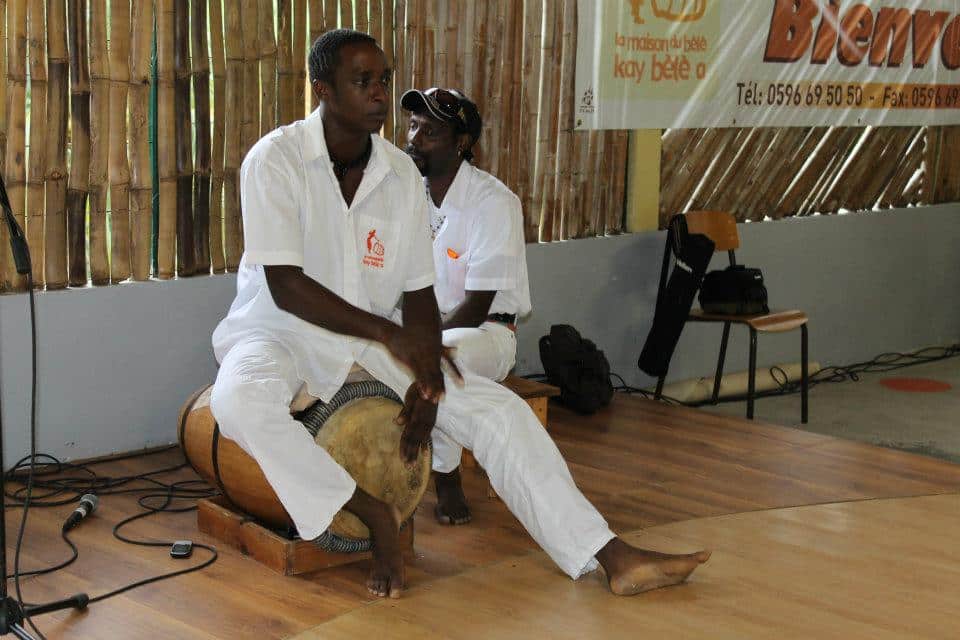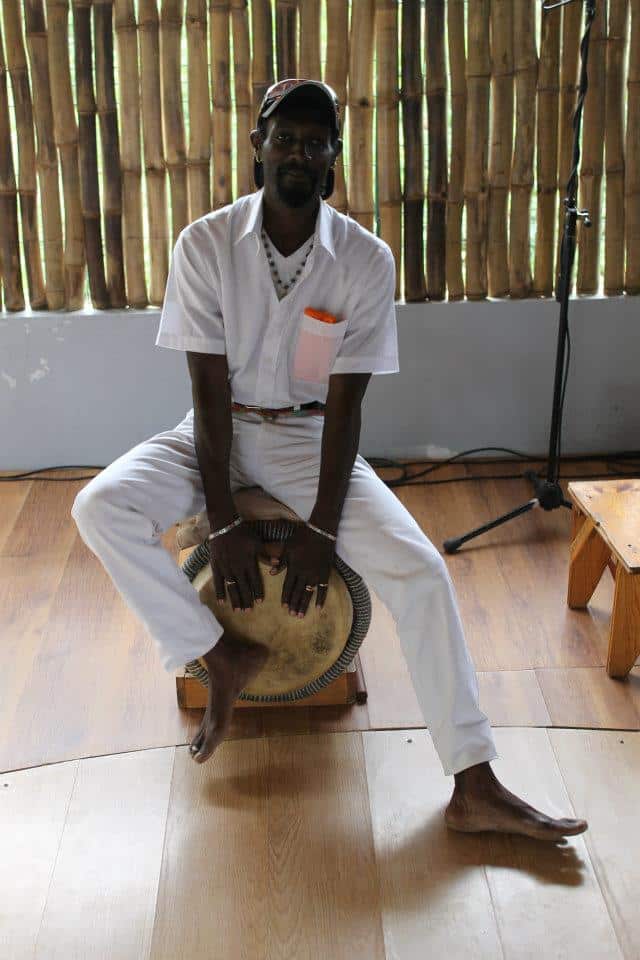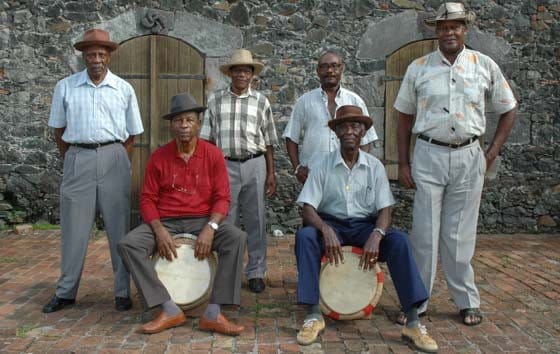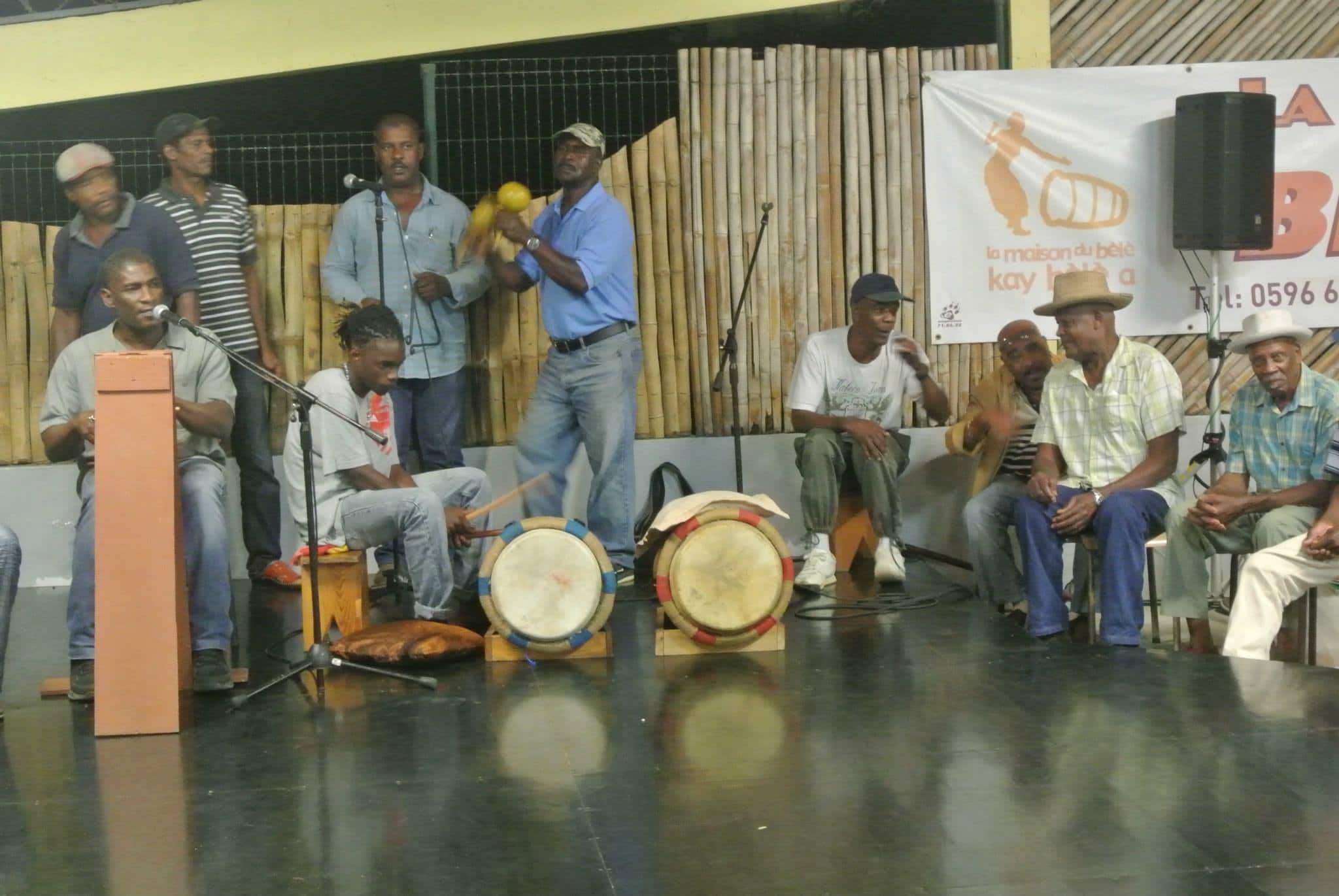Bèlè
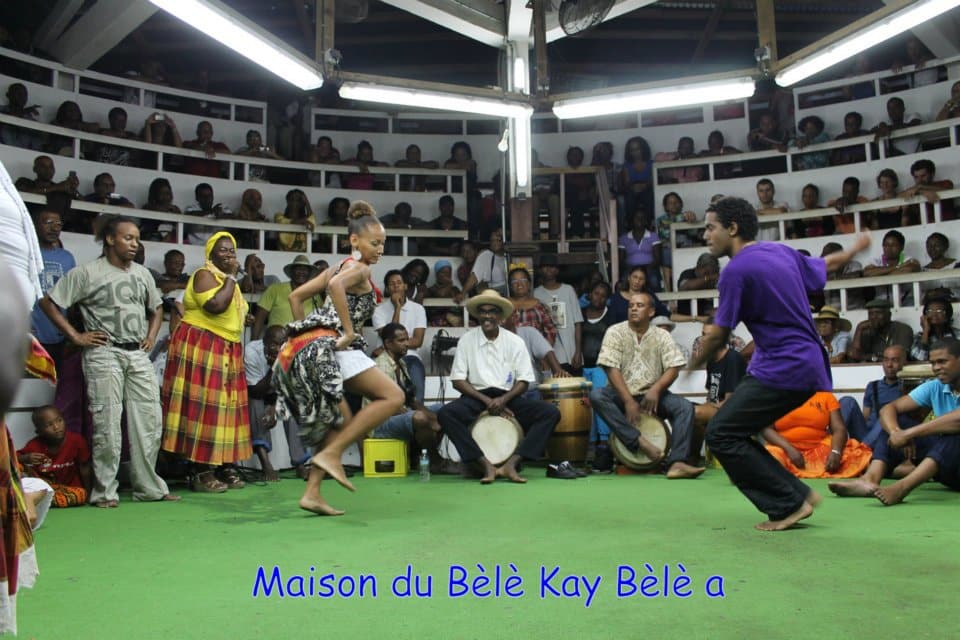
The question of the origin of bèlè is a real issue, linked to Martinique's turbulent past.
The island has been inhabited by a variety of civilisations, and has therefore benefited from a wide range of cultural contributions. From the 3rd to the 9th century, the Arawaks populated the island. They were decimated towards the end of the 9th century by the Caribs, who occupied the island until the 17th century, when they in turn were exterminated by the Europeans. In 1635, the first settlers moved to Martinique, and in 1638 the first slave trade began, which lasted until 1848, when slavery was abolished. The slaves came from different regions of black Africa and belonged to different peoples with different languages and traditions. The most represented ethnic groups according to historians were the Aradas, Congolese, Senegalese and Bambaras. These names designate the slaves according to their geographical origin, and group together several different ethnic groups. For example, the Aradas came from the Ivory Coast to the Gold Coast, and the Alladas from a town in present-day Benin.
This transplantation of black culture, European influence and the constraints of the slave system altered African musical traditions and gave rise to new musical expressions. The bèlè is one such expression.
It is not the addition of cultures, but a transcultural process in which it is difficult to determine the origin of each element. Bèlè music contains musical traits from different cultures, transformed over generations. However, it is possible to identify some predominant influences. From Africa, it has inherited the rhythms and the inseparability of song and dance. Similarly, the use of the drumhead and an idiophone struck on the body is a widespread formula on the African continent, particularly among the Bambara. It is also found in Cuba with rumba, and in Saint Lucia and Haiti, regions that have also seen a significant influx of African peoples. Apart from the instruments used, there are striking similarities in the dance and rhythms with the popular rumba of Havana and the capoiera of Brazil. The European influence is less obvious in the music than in other repertoires such as haute-taille. But in dance, it seems obvious: the quadrille is said to have been inherited from the eighteenth century and to have become the model. On the other hand, the choreographic figures, gestures and certain steps that accompany the dancers' movements are thought to have originated in Africa. Apart from the dance, it is difficult to identify European contributions. The music is essentially based on percussion, and the style of singing with answering machines is reminiscent of African formulas. On the other hand, the melody of the songs and the Creole language are thought to be the result of European-African syncretism.
Now the pride of Martinique, bèlè has its masters, its elders. Benoît Rastocle, Félix Caserus, Marcel Jupiter and Berthé Grivalliers are just some of the people who have passed on the memory of Martinique's identity. Source (le monde.fr).
What is bèlè?
Bèlè (also known as "bel air" after the French version of the Creole word) is a musical genre in which a singer leads the music with a powerful voice, while the dialogue develops between the dancers and the tambouyé (drummer).
It is always structured as follows: the singer provides the vocals, followed by the responders; the ti-bwa sets the rhythm, and finally the drum makes its entrance, followed by the dancers.
Responders: must always give the right phrase, the right intonation, and keep the rhythm, otherwise the singer will lose concentration and the music will become unbalanced.
The ti-bwa: made from two sticks, branches of hard woody trees (guava, tibom, coffee) that are cut and dried in the sun. It is played by a ti-bwatè (ti-bwa player) on the back of the bèlè drum and marks the rhythm with the sound of tak-pi-tak-pi-tak.
The bèlè itself is made up of several types of music:
- the working bèlès: fouyé tè, rédi-bwa, téraj kay, coupé kan-n, mazon-n and granson,
- entertainment bèlès: bèlè, gran bèlè, bélia, kalennda, danmyé and ladja,
- funeral wakes: bénézuel, kanigwé, karésé yo, ting bang,
- la lin' klè" dances: mabèlo, woulé, mango.
This music is played at very specific times: it accompanies the day.
In the old days, cocoa and coffee fields were quite far apart and spread over large areas on the mountainside. The gran son was sung as the fields were turned over. The rhythm of the hoe strokes was set by the kon' lambi (lambi conch shells) and the bubbling of the earth was told by the timbre drum. The big sound was sung by two male soloists with a wide range of voices. The earth was turned over on the way to the top of the mountain, after which it was furrowed on the way down the mountain. The mazon-n, a song for one voice, accompanied this phase of the work, with two kon' lambi marking the stroke of the hoe.
As well as providing a rhythm for the work, the songs were used to tell the story of the island, the community and the neighbourhood, and to provide an ironic account of disputes between settlers or the misfortunes of a comrade or foreman... At the end of the day, the Ladja or Danmyé was danced.
The danmyé is a fast-paced, upbeat way to unwind after a hard day's work. It is an invitation to dance. It is also a gentle form of the forbidden ladja dance.
Ladja is a combat dance accompanied by drums, ti-bwa and song. It was banned by the Catholic Church because of the use of drums (Africans used drums to communicate with their deities). Slower than danmyé, which gives it a more serious character, it was performed on Saturday evenings. Only the majô (majors in French) dance the Ladja, which sometimes ends with the death of one of the combatants.
A major is a dancer who is an authority. His only weapons are his body, his agility and his intelligence. Ladja requires long and rigorous preparation on the part of the majors and calls for a mastery of paranormal, supernatural elements, which some describe as quimbois, a rite equivalent to Haitian voodoo.
Today, three centres of bèlè can be found in Martinique: in the north of the Caribbean (Basse-Pointe and the surrounding area), Sainte-Marie, and the south (Anses d'Arlets, Diamant). The Maison du bèlè presents an exhibition of former bèlè players from Sainte-Marie, and its current work consists of getting in touch with former players from other communes to bring them out of the shadows and into the limelight.
The bèlè drum
"Originally, there would have been attempts to make drums directly from trunks, 'bwa fouillé', but this didn't develop. So it was the coopers who made the drums. Mastery of cooperage was very important at the time, particularly for shipping rum barrels. Some coopers were experts at shaping barrels and, quite naturally, they started making drums. It was easier than digging in the wood, especially as the slaves had no tools.
The bèlè drum is covered with a goatskin or sheepskin. Its sound is close to the earth, a little muffled, so it doesn't need an ox skin (even though I've been offered a drum made from a mule skin...).
To tighten the drum, we used whatever we had to hand: an iron circle onto which we fitted various plant materials (banana straw, rope, etc.). And we tightened it very hard. But without integrating the tightening system into the drum itself, unlike the gwoka drum in Guadeloupe, for example, where the tension of the skin can be adjusted with a set of strings.
The drum is played lying down, with the skin-covered opening slightly raised. The technique of the bèlè drummer involves moving the foot, the heel, to modify the sound. It is a rubbed, struck strike (and not a vertical, direct strike, as on vertically held drums).
The main playing is done by the right hand. The first and second phalanges of the fingers are used to strike the edge of the drum. The dexterity of the tambouyé means that there are several finger techniques and variations in the playing. You have to do it during the main strike with the right hand and then adapt it to the rhythm you're playing."
It is interesting to note that in Martinique many musicians played Guadeloupean gwoka before the movement to recognise the bèlè tradition. We have to salute the militancy of my father and his entourage, who fought to promote the elders, the mèt' bèlè (bèlè masters), so that they could communicate and there would be no break in the transmission between the old and the new," says Manuel Mondésir. Five years ago in Martinique, everyone was dancing salsa. Today, it's bèlè. All the projects that have been set up around bèlè mean that today the people of Martinique are proud of their music.
The bèlè, its rhythms and dances
Electronic reference: François BENSIGNOR,
"Martinique: bèlè of yesterday and today", Hommes & migrations
http://journals.openedition.org/hommesmigrations/698
DOI: https://doi.org/10.4000/hommesmigrations.698 "The bèlè is made up of different rhythms, in 2, 3 or 4 time. The 'bèlè rapid', the 'bèlè douce' and the 'bèlè pityé' are played to 2 or 4 beat rhythms. The 'gran' bèlè, 'belya' and 'marim bèlè' are 3-beat dances. The bèlè is danced bent over, with the knees bent, unlike the 'danmié', for example, which is a combat dance. The 'danmié' dancer must be able to bounce and throw his feet and arms in the fight.
There is something suspended in the rhythm, with syncopations that accompany the movements and 'waits' that allow the dancer to reposition himself.
The kalenda, another 4 beat rhythm, is the only dance in Martinique that is danced alone".
"The main dances of the bèlè nucleus are danced in a square structure, such as the quadrille or the gran bèlè. In the choreography of the quadrille, two squares intersect in a structured way. But within the two squares, the dancers perform individual feats in pairs...
The gestural and relational codes between the dancers need to be integrated into the movement. The grace, the exchanges in the dance and the rhythmic encounters are enough to interest a spectator who is new to the quadrille.
The 2 and 4 beat bèlè dances are divided into 'bèlè kourant', 'bèlè rapid', 'bèlè pityé' and 'bèlè douce'. The three-beat versions are 'gran bèlè', 'beliya' and 'marim' bèlè'.
"In addition, the swaré bèlè included dances that were part of moonlight games, which were not always accompanied by drums. These are dances in the round, in a line, involving games between the dancers. Examples include the 'venezuel', the 'kanigwé', the 'woulé mango' or the 'timbank', danced in the round. All these dances follow one another during a swaré.
It should be noted that practices differ between the north and south of the island. The same dance can also be performed in different ways. Let's just say that there is a central core of bèlè dance and that the different practices are gradually discovered with experience.
"The great masters of bèlè:
Ti Émile (Emmanuel Casérus), Ti Raoul (Raoul Grivalliers), Victor Treffe, Galfétè, Félix Casérus, Dulténor Casérus, Vava Grivalliers, Berthé Grivalliers, Clothaire Grivalliers, Féfé Marolany, Paul Rastocle, Benoit Rastocle, Carmélite Rastocle, Apollon Vallade, Félix Cébarec, Génius Cébarec dit Galfètè, Stéphane Cébarec, Boniface Cébarec, Saint-Ange Victoire, Robert Dessart, Siméline Rangon, Espélisane Sainte-Rose, Sully Villageois, Dartagnan Laport (famous family of drum makers), Julien Saban (Bèlè Baspwent).
The new generation :
Eugène Mona (1943-1991), L'AM4 (Georges and Pierre Dru), Kannigwé, La Sosso and the Wapa group, Edmond Mondésir and his Bèlènou group, XTremjam, Bèlè Boumbap de Kali, Lassao, Sully Cally, Jean-Philippe Grivalliers, Boris Reine-Adelaide, Jean-Pierre Mitrail (Alblana), Vwa bèl danm, Nénéto, Lébéloka, Bélya, Vaïty, Bèlè Légliz, Lèspri Danmyé, Manuéla M'La Bapté, Stella Gonis, Icess Madjoumba, Artana.
(wikipedia)
The foundation of Martinique society, bèlè is a complete art of speech, rhythm, music and dance. Folklorised in the 20th century and rejected by the elite, this popular art form is enjoying a meteoric rise to popularity. Over the last ten years or so, events and schools have been springing up all over the place. Young artists are taking hold of it and developing it further...
(Electronic reference: François BENSIGNOR,
"Martinique: bèlè d'hier et d'aujourd'hui", Hommes & migrations)
http://journals.openedition.org/hommesmigrations/698
DOI: https://doi.org/10.4000/hommesmigrations.698
Media




